So looking for some help with analysis of the failure of my L3 flight from those with more experience, insight etc.
Briefly the story of my L3 project "It's Awesome Time Baby!"
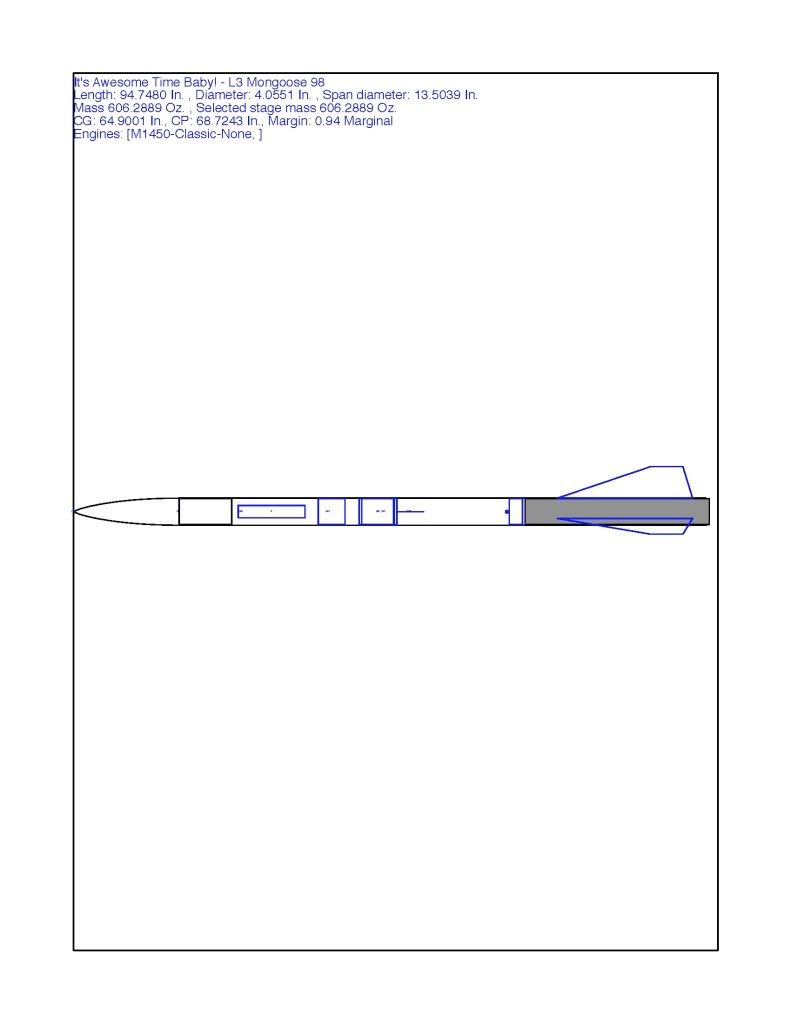
Its a 98 Mongoose with a redesigned zipperless coupler setup using the CTI 4 grain casing as a coupler.

I "borrowed" a design from John Wilke using a section of fiberglass coupler bolted on top of the motor casing in order to be able to place shear pins. Since I was using a CTI spacer to fly a 3 grain motor, I had to extend the motor retainer bolt up through the spacer and through the fiberglass coupler. Since I couldn't find a long enough closed eye bolt for this application I joined a section of all-thread to the closed eye bolt with a coupler. I tightened the all thread coupler and all the nuts into the fiberglass coupler and into the motor casing....
however....

I apparently didn't tighten it enough because this is what I recovered. You can see the fiberglass coupler in my hand. All thats missing is the fincan and motor casing. The eye bolt had come unscrewed from the coupler nut likely after apogee separation. Luckily I found this about a 1/2 mile away on a line back to the launch site....

Fortune had smiled on me (or at least I thought) because the fincan was intact with no damage and the casing was there as well. All well and good enough to fly again tomorrow providing I could find a motor...
So Joe had a motor that would work and the weather looked good on Sunday so I decided to give this L3 thing another shot. After discussion with my TAP I decided to trim the fiberglass coupler down so I could get a wrench and "really really" tighten the hell out of the eye bolt, plus I added a bunch of thread-lock. I got the motor and everything ready to go and after the 10 count off it flew again - nice straight boost. The GPS regained a signal after about 30 seconds from flight and was tracking it well about 2 miles north... then we heard an ominous "boom" sound and lost GPS lock but only after about a minute from launch. Not a good sign, especially considering the "boom" sound coming from the north.
About 1 1/2 miles away I spotted my main chute lying on the ground with the nosecone buried about a foot down and a foot away another hole. A lot of digging and I retrieved the nosecone still intact. Not so much for the rest of the rocket. The ebay was recovered - both apogee charges had fired - I used 2 grams for the primary and 2.5 grams for the backup apogee charges. (I had performed initial ground tests with 2 grams which gave a nice separation, however I had not re-preformed a ground test after I trimmed the coupler down by an inch). The back of the casing was found about 2 feet down and is still there - I decided to return with a much bigger shovel and a pick another day to see if its salvageable... Heres the rest of the stuff...
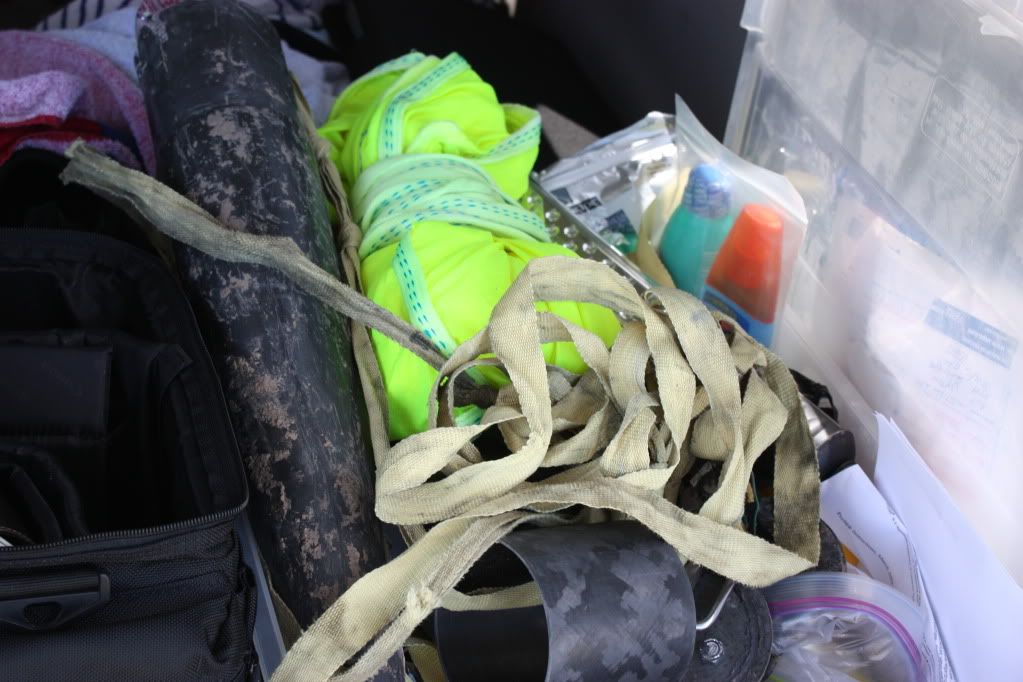
Basically the main chute survived.
My analysis of the flight is that the apogee charges failed to separate the rocket and it came in ballistic. The main charges fired and separated the rocket but it was likely supersonic (correlating with the noted "boom") at that point and so the parachute landed nicely next to the rocket impact site. Since the charges both fired this was not an electronics problem.
My two theories are that:
1) The trimmed down fiberglass coupler was now not resting on the motor casing and could "torque" in the tube and bind, preventing separation, especially since the length of the coupler was under 1 caliper of tube diameter - probably about 1.5" long, however it was bolted to the top of the CTI casing with washers supporting the bulkhead and a cinching nut on top of the bulkhead, effectively sandwiching the bulkhead between the end of the casing and the eye bolt. Remember the previous coupler setup had separated the day before (actually it separated too well you may recall!) So had cutting down the length of the coupler possibly caused this failed separation? or...
2) BP charge failure. As I mentioned I used 2 grams in testing with a great separation, and 2 grams with 2.5gr FFFF backup had worked the previous day without an issue. I have noted on one occasion of testing charges that the charge goes "pffffttt" rather than "boom" when testing. I have only seen this once using plastic centrifuge tubes and figured it was a freak occurrence and besides I had a back up charge in case the first didn't work. The back up charge was placed in the aluminum charge holder that is stock for the kit.
I used e-matches (I don't know the exact type - bought them from Joe) and had tested about 10 of them prior to this launch - one of them did the "pfffttt" thing, so I tested about 6 more without incident. I have heard rumor of the e-matches packing too much of a kick where they can possibly blow apart the charge prior to igniting the BP. So either not enough BP (however the day before and prior tests don't support this) or charge separation and decreased detonation due to the e-matches?
Those are my two possible theories. Any other thoughts, similar experience, etc would be welcome as I really, really really don't want to see this happen again.
A couple of additional notes after reviewing my post:
- the data on the Rocksim drawing is not the actual CP/CG for this flight, this drawing was pulled from an old file.
- An after thought as to what could have helped prevent this... a 3rd apogee charge possibly, especially given that apogee separation is much more important than main separation
or
program the altimeter (I was using Ravens) so that the 4th output charge could be programmed to fire the main chute in the event the apogee charges failed to separate it. Correct me if I'm wrong but I believe the Raven can be programmed to fire if Pressure is increasing and velocity is > X, pick a speed that is much faster than the rocket would fall under a drogue. So in essence you use the main as a back-up if no apogee separation occurs and the rocket is descending and velocity is increasing, however you do this before the rocket reaches a fast, say super-sonic speed, so you can rescue it. It may be a long recovery walk but in my case I'd take the hike over the shovel and bucket any day!
-Sean
Such a bummer 🙁 That was a beautiful rocket.
My guess would be the shortened coupler section tweaked sometime and bound. I know John Bixler flew a Loki K350 with that setup and it was a bear getting that coupler to stay round when tightening the bolt to the closure down tight. He did the small piece of coupler for the same reasons - needed a place to shear pin everything together.
On my L3 I machined an aluminum coupler that mated to the forward closure (used the RATT M900 64mm hybrid) that self centered and bolted down. It was ~3" long and was hollowed out. It was one of my worries was where to put bolts to hold my airframe - I can't really bolt through the case.
I wouldn't add additional charges. My first L3 attempt ( I did 3 b/c I had zippers) I did 4 charges, primary and backup, and the backups had a 2nd e-match in them. I got rid of the redundant e-match on the 2nd and 3rd flights and just went with 4 charges, two for each event.
Instead of programming the Raven for pressure increasing and below a certain velocity why not just program it for apogee + x seconds?
If you want to do the same thing let's get together and I can machine you an aluminum coupler for the top - we'll integrate a Wilke anchor into there so you don't have any more issues with cranking something down tight enough.
Edward
Sean, one way to get around the joiner nut on the eyebolt is to use an eye nut http://www.mcmaster.com/#eye-nuts/=7dh21k You run that down tight onto a piece of all-thread.. You can torque them down incredibly tight, use lock nuts, and also do the trick with the Kevlar that I showed you. The all-thread comes in sections up to 36", so you would have fewer places that could unscrew. I like the eyenuts...
That is a possible solution for the FIRST flight. Regarding the second boost - I have racked my brains as to why the charges would work on the first shot, but not the second. I have two theories that have floated to the top of my brain:
a.) was the shortened coupler short enough that the rocket could have "bent" a bit under boost, causing that section to bind?
b.) after you cut off the coupler, was your drogue compartment made larger (meaning more charge would have been needed to pressurize the area)?
Like you, I'm grasping a bit. I had a rocket called "MayheM" (conceived and flown years before the original MHM) that did the very same thing. To this day, I sorta wonder what went awry.... Why it didn't separate is STILL a mystery. It is one failure I didn't learn much from - because I don't know why it failed. That is frustrating indeed --
Is there a chance the Raven data is recoverable? The accel data might provide a clue about what happened when the charges went off.
How short was the connection area after the coupler was shortened? The only theory I have that even remotely makes sense is that perhaps the coupler bound - glass and carbon tend to do that when only inserted a short distance. Even that seems unlikely, but it's the best I can think of. How badly damaged are the altimeters? As Adrian said, it would be great to see data.
I'm really sorry to see this though - that was a gorgeous rocket.
I found some more photos if that may help the discussion.
Here's a photo of the coupler I was talking about with the all-thread extension through the spacer. In the 2nd flight the spacer was not used and the coupler was cut down about 1 inch.

I went out today with superior digging tools to attempt to recover the casing. Heres a photo of the casing in the ground, its about 2 feet down.

And after an hour of digging I got the casing free. Not quite what I was hoping for after all that work but thats what a high velocity impact can do to a casing I guess.
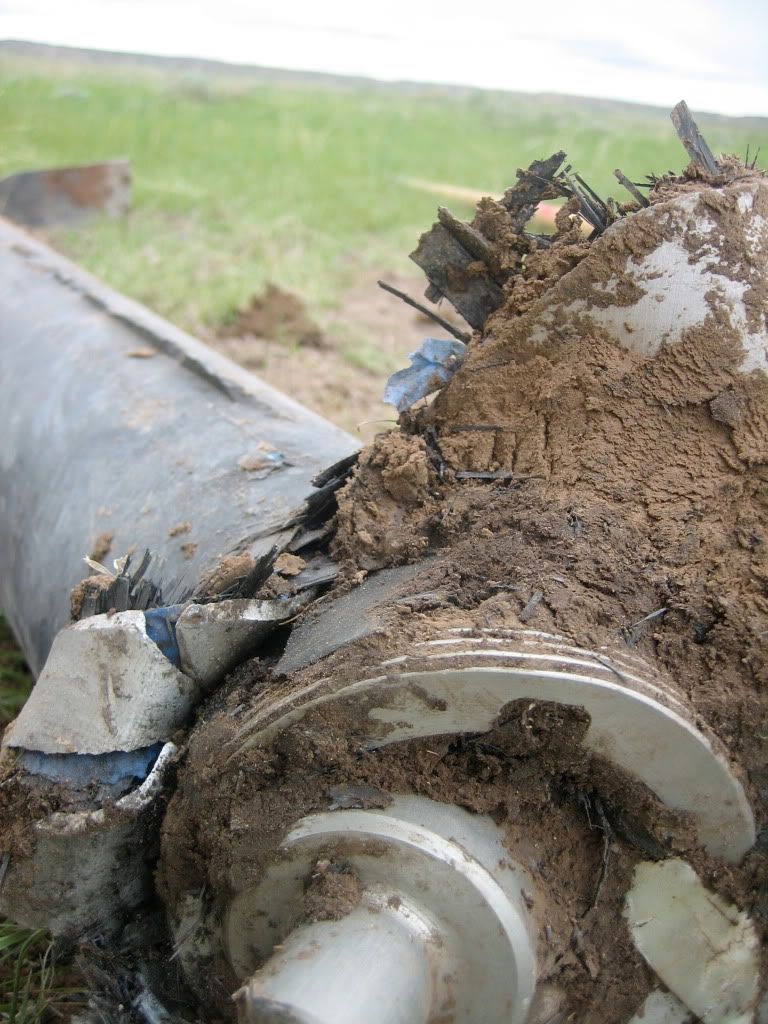
Just based on my experience with a similar size 4" bird, while 2grams and 2.5 grams might reliably separate the airframe on the ground, it was not sufficiently reliable under flight dynamics. Twice it came in either partially deployed or just separated without deployment. Since then I've essentially doubled my charge size on this bird and have 100% reliable deployment since.
Warren
Adrian if you can somehow pull some data off of these that would be amazing:
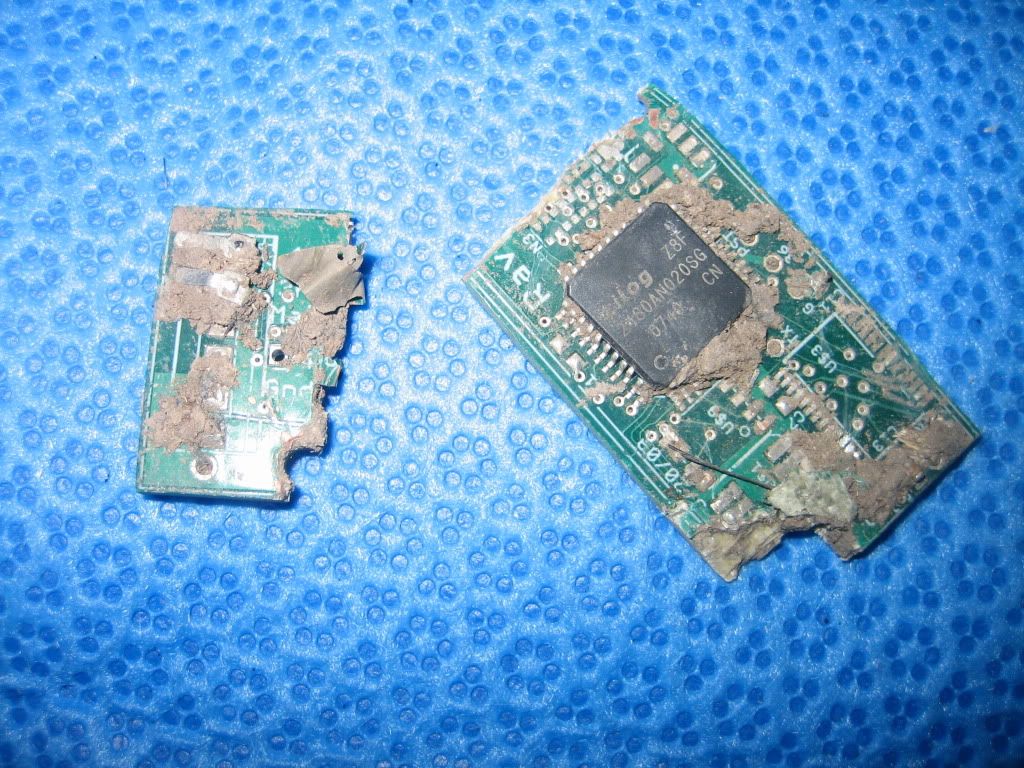
Doug downloaded some of the GPS data from the Garmin DC 20 system I was using and ballpark data from the GPS put the flight at 33,000+ feet AGL. So its also possible the BP had reduced efficacy at a significantly higher altitude.
Chris the coupler was shortened about an inch. In my original desing it rested on the casing, once I trimmed it down the only thing supporting the fiberglass coupler was the all-thread and the washers sandwiched between two nuts, so it would have been easier for the coupler to torque and possibly bind.
Was it only connected up to that mark on the coupler? If so, that does seem awfully short, and it lends credence to the idea that maybe the coupler bound.
Warren: Doubled? 4+g in a 4"? I'm sure it separates quite reliably, although that seems a bit unnecessary. I've had essentially perfect luck with 2.5g or so in my AMRAAM for drogue (4"), and I used 4g in my L3, which had significantly more volume to pressurize.
As for the reduced efficiency, I've noticed that even in a 17k flight - I had my AMRAAM just barely separate on the M1300 last October, but it did not have any significant charge containment. For my L3, I went to a much more thorough surgical tubing and electrical tape containment, and deployment at 18+k was quite solid. How were you containing your charges?
What method did you use to hold your charges?
Edward
The green mark on the coupler was used for shear pin alignment. Maybe I'm not explaining it clearly but the motor casing was used as the coupler - It had about 4.5" of casing in the upper body tube and then the fiberglass coupler extended above that another 2.5". When it was shortened for the second flight the coupler was still the same height but now there was a gap between the fiberglass and the casing so I could get a wrench in there.
Yeah maybe I shouldve gone with more BP. The calculated charge amount by equation was 2 grams and thats what I tested it with successfully. Maybe for the next flight Ill go with the old addage - yeah that amount seems about right, better double it!
It was very wierd being out at the launch site with no one else there, quite a stark contrast from last weekend.
-Sean
The 2 gram charge was in a plastic centrifuge tube, ematch epoxied through the bottom with lots of electrical tape, the 2.5 gram charge was in a metal charge container that was part of the ebay setup - the BP was packed tight with wadding and a plastic cap which was then electrical taped over it.
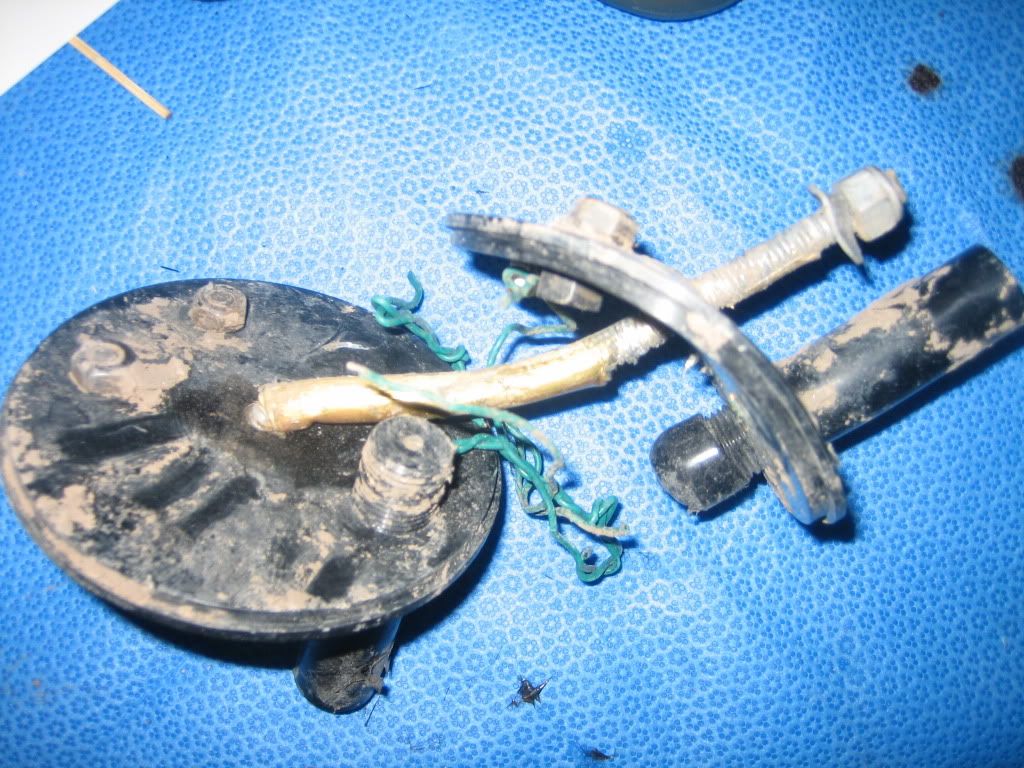
You can see the metal charge holder on the right.


